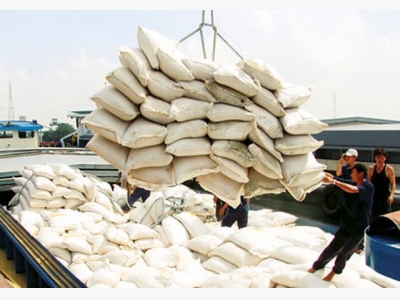Vietnams March rice exports hit one-yr high as top buyers grow hungry

In the long run, top buyer China's imports are forecast to fall to 4.5 million tons in the marketing year to June 2018.
Vietnam exported 550,700 tons of rice in March, the highest monthly figure in a year, with demand from China and several key buyers including Singapore and the Ivory Coast rising, Vietnam Customs data shows.
The actual loading volume last month is the highest since March 2016 and also marks the first time in the past year when the monthly export volume from the Southeast Asian nation rose beyond 500,000 tons, based on data released on Monday by the Finance Ministry's customs agency.
Vietnam is the world's third-largest rice exporter after India and Thailand.
China, its biggest buyer since 2012, imported 286,100 tons in March, nearly double the amount from the previous month, while Vietnam's shipments to Singapore soared about 10-fold to 50,300 tons in the same period, Vietnam Customs said in a monthly report.
The Ivory Coast took delivery of 6,700 tons last month, also nearly ten times the amount it bought in February and the meager 397 tons it imported the same month last year, the report said.
Traders said Singapore-based trading firms use their location for shipping documents, while most of the Vietnamese rice destined for Singapore has in fact been going to other regional markets and Africa.
Overall, Vietnam shipped 1.29 million tons in the January-March period, down 17.5 percent from a year ago, extending a decline seen since May 2016, based on customs data. The fall so far in 2017 is due in part to a lack of demand from the Philippines and Indonesia, traders said.
China is forecast to import 5 million tons of rice in the 2016/2017 marketing year ending this June, up from 4.8 million tons a year ago, the U.S. Department of Agriculture has said.
But China's rice imports in the next year starting this July are forecast to drop to 4.5 million tons due to "diminished price competitiveness of imported supplies as well as restrictive measures for export sales to China," a USDA attache said in a report released last week.
"As China’s foreign exchange reserves dwindle and prospects for foreign exchange rate adjustments rise, arbitrage opportunity for imports has narrowed," said the report, dated April 4.
Besides, China had granted rice export licenses for only 22 Vietnamese firms as of January 1, 2017.
Last year, Vietnam's overall rice exports fell to 4.8 million tons, the lowest since 2008, due to better production in key markets such as the Philippines, Indonesia and Malaysia, as well as rising competition from India, Pakistan, China, Thailand, Myanmar and Cambodia.
Prime Minister Nguyen Xuan Phuc has called for another "revolution" to raise the quality of rice production and boost export value.
The first revolution started in the late 1980s when rapid reforms in agricultural production helped turn Vietnam into a rice exporter after having to import the grain for several years.
The Vietnam Food Association has targeted annual rice exports this year to edge up slightly to around 5 million tons.
This week, Vietnam's benchmark 5-percent broken rice prices eased to $347-$350 a ton, free-on-board Saigon Port, from $352-$355 last week, traders said.
But the current prices are still above the average price of $344 in the first quarter, as estimated by the U.N. Food and Agriculture Organization.
Related news
 Dutch plant seeds of cooperation in Vietnam
Dutch plant seeds of cooperation in Vietnam The visit to Vietnam of a Dutch business delegation headed by the Netherlands Vice Minister for Agriculture, Marjolijn Sonnema, opened up opportunities
 Vietnamese fresh fruit segment loses the domestic market
Vietnamese fresh fruit segment loses the domestic market Nearly 70% of the land in the country is suitable for growing produce, and more than half of the population works in the agricultural sector.
 Dairy firm imports high-yield cows from the US
Dairy firm imports high-yield cows from the US Vietnamese diary TH Group is preparing to receive 1,290 Holstein Friesian (HF) high-yield dairy cows imported from the US.